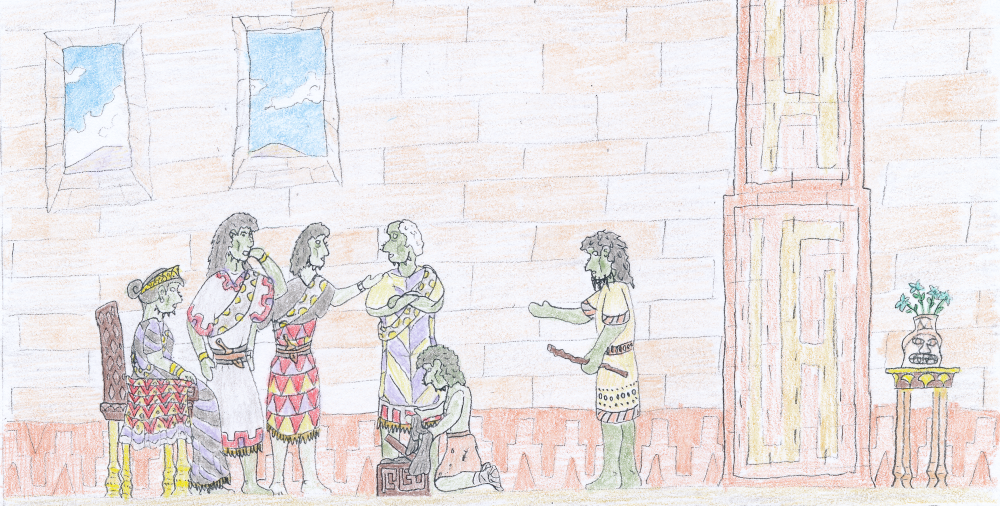Kóhans
Kóhans1 are Gobíls who rule several city-states in Darlaa, a region in the western Múlíat Mountains in southern Dragonía.
Each city-state is centered around a fortified settlement, usually built on a hill with a good view of the surrounding landscape, ruled either by a queen or an oligarchy of matriarch representing each family of nobles, whose husbands -polyandry is the norm among Kóhans- and sons form the core of the army, and some act as priests of various deities as well.
Currently, the most powerful city-states are Káx in western Darlaa, Gahlúk to the north and Óxúrp to the southwest.
Homes are generally laid out in the same way, with a square or rectangular floor-plan centered around a courtyard. As in other sedentary Gobíl societies, the men share a large room where they eat and sleep, while every woman has her own bedroom, each of which is sometimes connected to a small, walled garden. This is because Gobíl women are generally more aggressive and territorial than the men, and thus need their own space within the home to avoid conflicts.
The gods are offered animals for the most part, though human sacrifice is practiced either during important festivals or during droughts, plagues and other disasters.
A number of customs must be observed when near a mekár, such as speaking in hushed tones, avoid playing instruments and to not touch the remains there. A shepherd offers the queen of Káx woolen cloth as a tribute.
History
Kóhans, like Hrens, are descendants of Proto-Gobíls who were once found in the northern Múlíat Mountains, specifically the southern tribes who had adopted nomadic pastoralism in favour of traditional hunting and fishing, and migrated in several waves southward to the region of Darlaa. There they eventually supplanted many of the native peoples there, and founded a number of city-states, while others expanded further south into the Dakrúzú Peninsula or the Sjorg Desert.Society
Kóhan societies are divided into three classes: an aristocracy of noble families, warriors, priests and priestesses; commoners, including craftsmen, antelope- and shepherds; and slaves, whose work includes such things as spinning wool, tanning and mining. In general, most slaves are descended from some of the earliest Gobíl tribes who settled in the region, while commoners and nobles represent later waves who conquered the former.Each city-state is centered around a fortified settlement, usually built on a hill with a good view of the surrounding landscape, ruled either by a queen or an oligarchy of matriarch representing each family of nobles, whose husbands -polyandry is the norm among Kóhans- and sons form the core of the army, and some act as priests of various deities as well.
Currently, the most powerful city-states are Káx in western Darlaa, Gahlúk to the north and Óxúrp to the southwest.
Culture
Apparel
Kóhan clothing consists of belted, woolen tunics for men and long dresses for women, except for slaves, who wear little more than loincloths made of coarse cloth or animal skins. Nobles wear brightly coloured clothes along with a special sash, which acts as a heraldic device, while commoners adorn their clothes with bone fragments and beads.Art
Architecture
Palaces and mansions, temples and city-walls are all constructed out of stone, while other buildings are mostly made from clay or sun-dried bricks. Market squares are located either within or just outside cities, often paved with flat stones of different colour.Homes are generally laid out in the same way, with a square or rectangular floor-plan centered around a courtyard. As in other sedentary Gobíl societies, the men share a large room where they eat and sleep, while every woman has her own bedroom, each of which is sometimes connected to a small, walled garden. This is because Gobíl women are generally more aggressive and territorial than the men, and thus need their own space within the home to avoid conflicts.
Religion
As in all Gobíl societies, the most important deities in the Kóhan pantheon are the sky goddess and earth god, along with a number of other deities such as Strjúxá, goddess of the moon and war, the sun god Aha and Hnepax, goddess of animal slaughter. Aha is especially worshipped among the southern Kóhans, where priests and priestesses play trumpets, drums and rattles at certain times each day to scare off monsters that would otherwise try to devour the sun.The gods are offered animals for the most part, though human sacrifice is practiced either during important festivals or during droughts, plagues and other disasters.
Funeral rites
Within every Kóhan city-state is at least one place, usually on a hill or other prominent landmark commonly known as a mekár, to which the elderly are expected to travel (or be carried to) and await their death. This allows them to reflect on and prepare for the long and perilous journey to Terxaní, abode of the gods on the summit of Exirglarp, the tallest mountain in Dragonía.A number of customs must be observed when near a mekár, such as speaking in hushed tones, avoid playing instruments and to not touch the remains there. A shepherd offers the queen of Káx woolen cloth as a tribute.
1Original icelandic: Kóhar, singular: Kóhi.




Comments